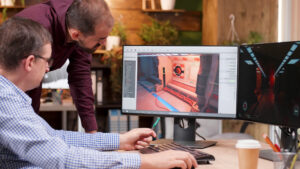From Sketch To Screen: The Evolution Of Graphic Design

Have you ever wondered how graphic design has evolved over the years? From simple sketches to intricate digital designs, the field of graphic design has come a long way. But what are the factors that have influenced this evolution?
Graphic design plays a crucial role in our visual world, from advertising and marketing to website design and branding. It has the power to convey messages, evoke emotions, and create memorable experiences. But how did it all begin? How did graphic design transform from hand-drawn illustrations to the digital masterpieces we see today?
The evolution of graphic design is a fascinating journey that showcases the creativity, innovation, and technological advancements of the industry. From the early days of pen and paper to the modern era of digital tools and software, each milestone has shaped the way we perceive and interact with visual communication. Join us as we explore the captivating story of how graphic design has evolved from sketch to screen.
Pre-Industrial Revolution: Handcrafted Artwork
Before the advent of industrialization, graphic design was a labor-intensive and artisanal craft. During this era, skilled artisans meticulously created visually compelling artwork using traditional methods and techniques.
The historical context and cultural influences of the time greatly shaped graphic design. Art movements such as the Renaissance and Baroque periods, as well as societal events like the invention of the printing press, played pivotal roles in shaping artistic expression. These influences resulted in the development of distinct styles and aesthetics that are still admired today.
Artisans utilized a variety of materials, tools, and techniques to produce their designs. Hand-drawn illustrations, calligraphy, and hand-carved printing blocks were commonly used. Colors were derived from natural pigments found in plants, minerals, and insects. The use of gold leaf and other precious materials added a touch of luxury and opulence.
The process of creating these handcrafted designs involved great skill and patience. Artists painstakingly sketched, traced, and painted their designs onto various surfaces such as paper, vellum, or parchment. They employed techniques like engraving, etching, and burnishing to transform these designs into prints and reproductions.
The era of pre-industrial revolution graphic design marked a period of exquisite craftsmanship and attention to detail. The methods and techniques developed during this time laid the foundation for the evolution of graphic design as we know it today.
Industrial Revolution to Digital Age: Technology’s Impact on Design
The Industrial Revolution and the rise of the Digital Age have had a profound impact on the field of graphic design, transforming it from a labor-intensive craft to a technologically-driven industry.
During the Industrial Revolution, advancements in machinery and manufacturing processes revolutionized the designing and production of printed materials. The invention of the steam-powered printing press by Johannes Gutenberg in the 15th century allowed for mass production of books, leading to increased demand for graphic design services. This development marked the beginning of a shift towards more accessible and widespread visual communication.
Fast forward to the Digital Age, which began in the late 20th century and continues to evolve today. The rapid growth of technology and the rise of the internet have ushered in a new era of design. Designers now have access to cutting-edge software tools such as Adobe Illustrator and Photoshop, which have significantly enhanced their ability to create and manipulate visual elements.
The advent of the digital sphere has also challenged designers to adapt to new mediums and platforms. With the proliferation of websites, social media, and mobile applications, graphic designers now need to consider how their designs will be experienced digitally. This has led to the emergence of specialized fields within graphic design, such as web design, UX/UI design, and motion design.
Furthermore, the Digital Age has brought about significant changes in the way designers showcase their work and learn new skills. Portfolio websites and freelancer platforms have given designers a platform to showcase their work to a global audience and connect with potential clients. Online learning platforms have made education and skill development more accessible than ever before, allowing designers to stay updated with the latest trends and technologies.
Modern Graphic Design Trends
Modern graphic design trends have seen a significant shift with the advent of digital spaces and the rapid advancement of technology. These changes have had a profound impact on designers’ tools and approaches, leading to new design styles and popular techniques.
With the rise of digital technology, designers now have access to a wide range of design tools that allow for greater creativity and efficiency. Software like Adobe Illustrator and Photoshop have become staples in the industry, enabling designers to create stunning visuals and manipulate elements with ease.
Additionally, the digital landscape has given rise to new design styles that prioritize minimalism, clean lines, and bold typography. Flat design and material design have gained popularity, emphasizing simplicity and clarity in user interfaces. On the other hand, vintage and retro aesthetics have made a comeback, adding a nostalgic touch to branding and advertising campaigns.
Keeping up with these modern graphic design trends is essential for designers to stay relevant in a highly competitive market. Being aware of the latest techniques and styles not only allows designers to create visually appealing designs but also ensures their work resonates with contemporary audiences.
Popular Software for Creating Digital Designs
When it comes to creating digital designs, there are several popular software options to choose from. These software tools provide designers with powerful features and functionalities to bring their creative visions to life.
- Adobe Photoshop, one of the most well-known graphic design software, offers a wide range of tools for photo editing, image manipulation, and digital painting. It is especially useful for creating intricate graphics and applying various effects.
- Adobe Illustrator is perfect for creating vector-based graphics and illustrations. It offers precision and versatility, making it ideal for logo design, typography, and intricate artwork. Its pen tool allows designers to create smooth, scalable designs.
- Adobe InDesign is designed specifically for layout design, making it an excellent choice for creating brochures, magazines, and other print publications. It offers precise control over typography, page layouts, and graphics placement.
- Sketch is a popular choice for user interface (UI) and user experience (UX) design. It offers a streamlined interface and powerful vector editing tools, making it easy to create responsive designs for websites and mobile apps.
- CorelDRAW is a versatile software that combines vector illustration, layout design, and photo editing. It offers a range of advanced tools for creating detailed artwork, logo design, and print layouts.
Each software option has its own strengths and suitability for different design tasks. With these popular software options, designers have the tools they need to create stunning digital designs.

Conclusion
In conclusion, the evolution of graphic design has greatly impacted the field of visual communication and the development of form. Technology has played a significant role in shaping this evolution, enabling designers to explore new creative possibilities and push the boundaries of their craft.
Today, graphic design is a multifaceted discipline that encompasses various mediums, from print to digital. Modern trends in design constantly evolve, reflecting society’s changing aesthetic preferences and the emergence of cutting-edge technology.





